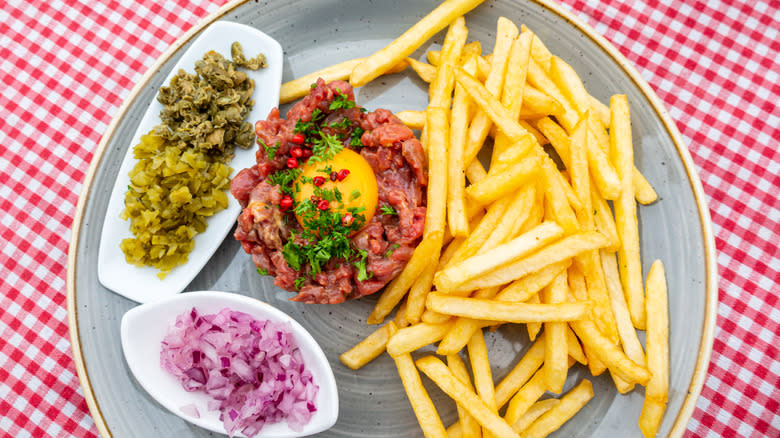French Vs Polish Steak Tartare: What's The Difference?

Raw foods pack in a distinct appeal, showcasing local ingredients and flavors in an unfiltered way. Sure, it can be a salad, or a plate of local chopped fruit, but there's a special intrigue about raw proteins. Just consider the mesmerizing flavors and appearance of fish served in the different forms of Japanese sushi or Mediterranean crudo. Meanwhile, meat eaters can sample mett, Germany's raw pork sandwich, or the more famed steak tartare, which is widely enjoyed across Europe.
Most associate steak tartare with France, but it's also commonly eaten in Poland, too, where it's called befsztyk tatarski. Although regions have distinct culinary traditions, their usual rendition of the dish is surprisingly similar to the French one. It's all about an uber-fresh beef tenderloin, uniformly diced, and flavored with a variable array of aromatics, like sauces, onions, mustard, pickles, and herbs. In fact, it's possible both versions borrow from a common historical source, with the name a reference to the Tatar people.
For some, the dish may feel intimidating, seemingly a burger patty that hasn't hit the grill. And unfortunately, the USDA does advise against consuming raw ground beef. However, find yourself in Europe and give both of these renditions a try. When done well, they simply showcase high quality beef, flavored with local French or Polish ingredients selected by the chef.
Read more: Your Guide To The Different Cuts Of Steak
What Is French Steak Tartare?

Steak tartare is one of France's most popular dishes, found readily in bistros, and a common recipe in cookbooks. It emerged at the turn of the 20th century, with one of the first in-print references by famed culinary chef Georges-Auguste Escoffier. Interestingly, the technique was first referred to as à l'Américaine and served with tartare sauce, perhaps as people thought uncivilized Americans consumed raw beef.
Well, especially when prepared with French culinary finesse, there's nothing primitive about the dish. It conveys the delicious flavor of freshly chopped beef. The exact meat differs (veal is common), but favors a tender cut, like aptly named tenderloin, sirloin, or some sort of filet. It's preferable the protein is sourced from a high-quality small farm, via a trusted butcher. And for both food-safety and taste, it's imperative that the beef is chopped to order, often briefly pre-frozen to create its unique texture.
Classic additions to the dish for French steak tartare include the country's beloved dijon mustard, parsley, gherkins, and onions, especially shallots. Oftentimes, it's all tied together with an egg yolk, and a varied seasoning that involves anchovies, Worcestershire sauce, Tabasco, and even ketchup. The dish is typically eaten with bread, although the French sometimes serve it with fries, or a salad. Such a range showcases that although it's principally one chopped ingredient, there's a whole lot to consider. So, do follow some tips for making a delicious homemade steak tartare at home if you're feeling inspired.
What Is Polish Steak Tartare?

Steak tartare is a significant dish in Poland's culture, enjoyed as an appetizer during holidays, events, and other celebratory occasions. Thanks to a system of meat rationing, the dish endured through the communist period as everyone had access to low-cost beef. This was an unusual occurrence since the political style often destroyed many local cuisines. Today, befsztyk tatarski continues to be a prevalent food, although the price of beef has made it more common in upscale restaurants.
This steak tartare recipe follows a similar form to its French counterpart, but with local inflections. High-quality cuts like filet mignon or tenderloin are also employed for the job. And to create the beautiful extra-rich texture, a raw egg yolk is also mixed in. You'll often find it served on top and mix it in yourself. Other flavors that are kept similar include components like anchovies, onions, and parsley.
From there, this version folds in herbs like lovage, local grain mustards, and dill pickles for a distinctly Polish touch. Other additions like pickled mushrooms might be integrated into the mix, as well as a different oil like vegetable, or rapeseed. Plus, it's often served in a more casual hand-formed patty, as opposed to the French ramekin form. Alongside, Poles enjoy thick-cut toast, as well as more pickled vegetables and onions.
Both Dishes Have A Complex Culinary History

Steak tartare takes on a unique history, that's often accredited to the Mongolian invasion of Europe in the 13th century. After the attack, the group became referred to as Tatars and a tale spread that the invaders ate raw chopped meat. In Poland, it's believed the Asian warriors introduced the dish after an alliance. To further this theory of culinary exchange, Poland's cherished homemade pierogies also emerge from the same Asian culinary source. So while exact origins are unclear, it's possible that some version of the dish has been enjoyed in the European nation since the Middle Ages.
Meanwhile in France, origins are more recent, with the first steak tartare renditions only first appearing at the end of the 19th century. There, the term tartare also alluded to foreign foods inspired by the Mongol invasion, but in this case, it's in reference to simple tartar sauce. When chef Escoffier discovered the condiment came by way of Poland, he accordingly renamed it à la polonaise. And with the sauce's aromatics fusing so well with raw beef, some cite it was the sauce that gave rise to the dish and its name.
The connection between the word tartare, the raw meat dish, and Polish-French culinary exchange is convoluted. However, it evinces there's a tangled relation of a common history, furthered by the fact that steak tartare also appears in many other European cuisines, all slightly differentiated by regional flavors.
Read the original article on Tasting Table.


